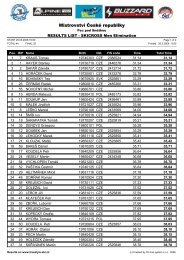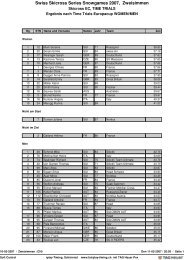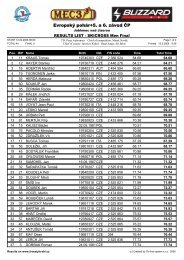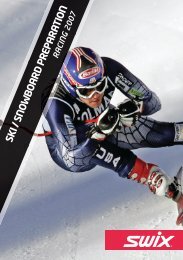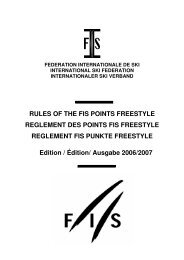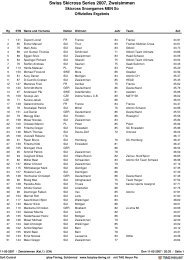Alpine ski and snowboard preparation - Skicross.cz
Alpine ski and snowboard preparation - Skicross.cz
Alpine ski and snowboard preparation - Skicross.cz
Create successful ePaper yourself
Turn your PDF publications into a flip-book with our unique Google optimized e-Paper software.
SKI / SNOWBOARD PREPARATIONPERFORMANCE 2007<strong>Alpine</strong> <strong>ski</strong> <strong>and</strong> <strong>snowboard</strong> <strong>preparation</strong>
<strong>Alpine</strong> <strong>ski</strong> <strong>and</strong> <strong>snowboard</strong> <strong>preparation</strong>PERFORMANCE USER LEVELThis is the level for alpine <strong>ski</strong>ers <strong>and</strong> <strong>snowboard</strong>ers who use their equipment often <strong>and</strong> want to get the mostout of their equipment. The focus is on achieving “the optimal feel”.STEEL EDGE AND BASE TREATMENT WITH SWIX PRODUCTSIn a few simple steps, you can prep your <strong>ski</strong>s or <strong>snowboard</strong> to gain higher performance from your equipment.These simple steps can help you improve the glide <strong>and</strong> turning properties of your equipment significantly,<strong>and</strong> should also give you greater confidence that your equipment will optimise your <strong>ski</strong>ing experience.The greatest benefits come when <strong>ski</strong>ing on hard surfaces.T149-50New <strong>ski</strong>s <strong>and</strong> <strong>snowboard</strong>sNew <strong>ski</strong>s <strong>and</strong> <strong>snowboard</strong>s that have not been pretreatedat the shop should be given a base treatmentbefore use. A base treatment ensures the bestpossible starting point for the original surface coating<strong>and</strong> improves glide properties. The edges shouldalso be sharpened in order to ensure the bestpossible carving properties on snow <strong>and</strong> ice.Sharpened steel edges provide you with bettercontrol <strong>and</strong> feel when turning, <strong>and</strong> is like puttingnew tires on your car – the equipment will be moreresponsive <strong>and</strong> tuned to your body, <strong>and</strong> you willgain more confidence in your <strong>ski</strong>ing abilities.When prepping <strong>ski</strong>s <strong>and</strong> <strong>snowboard</strong>s, a vise will helpyou work more easily <strong>and</strong> efficiently. We recommendT149-50 for alpine <strong>ski</strong>s <strong>and</strong> SB31 for <strong>snowboard</strong>.For alpine <strong>ski</strong>s retract the <strong>ski</strong> brakes with the T165Brake Retainer.SB31T165ADVICE:When treating the surface <strong>and</strong> steel edges,always start by prepping the edges first, which willensure that you avoid getting wax on the filing tools.When the <strong>ski</strong> or <strong>snowboard</strong> is new, start the<strong>preparation</strong> by establishing the edge geometry(edge bevels). The key to obtaining optimal carvingproperties on snow <strong>and</strong> ice is to ensure that theedges are as smooth <strong>and</strong> even as possible.2 SWIX SPORT - SKI/SNOWBOARD PREPARATION
Three important areas when prepping edges• Base edge• Side edge• Sidewall (Edge offset)BASE EDGE:1.0°0.5°SidewallSki/SnowboardSteel edgeBase materialGenerally 0.5 to 1 degree bevel1. Base edge:• Make sure that the base edge is level with the basesurface. Scraping the base surface is more difficult ifthe edges are too high, <strong>and</strong> this may also causeproblems steering (erradic “hooking” effect).By beveling the base edge 1 degree, the edges willnot grab immediately when you are <strong>ski</strong>ing, but youwill gain control progressively, which will allow you toturn your <strong>ski</strong>s or <strong>snowboard</strong> more easily.• Place the <strong>ski</strong> or <strong>snowboard</strong> in the horizontalposition in the vise (base up).TA3002• For coarse filing of the base edge, use TA3002.Put the file in position for filing the base edge.If you mark the edges with a marker before you start,you can see the effect the file is having. Bevel thebase edge 1 degree (see illustration). Using overlappingmovements, file by moving the file holder fromthe tip to the tail.SIDE EDGE:2. Side edge (<strong>and</strong> sidewall):• Place the <strong>ski</strong> or <strong>snowboard</strong> in the <strong>ski</strong> vise ina vertical position <strong>and</strong> with the base facing awayfrom you (see illustration).Generally 87 to 89 degree bevelSIDEWALL:Ski/SnowboardSteel edgeBase materialTA101• In order to obtain optimal carving properties onsnow <strong>and</strong> ice, bevel the side edge 3 degrees,which will produce a sharper angle between thebase edge <strong>and</strong> side edge (see illustration).• Before coarse filing the side edge, we recommendthat you remove some of the sidewall offset (seeillustration); this will allow you to avoid filing thesidewall with the file <strong>and</strong> to focus your efforts onfiling the steel edge. Use the special tool SwixTA101. You will have to repeat this procedureperiodically when the side edge is filed down tothe point where the sidewall <strong>and</strong> side edge are even.Make sure to not remove too much at a time.SWIX SPORT - SKI/SNOWBOARD PREPARATION 3
SIDE EDGE FILING:• Now you can start coarse filing the side edge.Use TA3002. Fasten the file in the holder in the appropriateposition for working on the side edge. File from the tip tothe tail, using a pattern of overlapping strokes.TA3002Generally 1 to 3 degrees resulting in a total edge angleof 87 to 89 degrees.3. Removing burred steel from filing:• When coarse filing the edge, burrs can develop on theedge. Unless such burrs are smoothed off, the edge willbecome rounded <strong>and</strong> duller more quickly.TAA400S - 70 mm• Use the diamond stone TAA400. Work with the stoneback <strong>and</strong> forth along the entire side edge <strong>and</strong> base edge(see illustration). The edges should now be sharp <strong>and</strong>polished without any irregularities.4. Maintaining sharpness of edges:• As with knives, it is not necessary to use a file every timeyou need to sharpen the steel edges. A diamond stone,TAA400 can be used instead (see illustration). Using sucha tool will save time <strong>and</strong> the result is usually excellent.If you still feel that the edges are not sharp enough,then apply the file in the same manner as describedin the base treatment of the edges.TAA400S - 70 mm5. Rounding/dulling of edges in front <strong>and</strong> back:• Some prefer to dull or detune the edges in the front <strong>and</strong>back sections of the <strong>ski</strong>s or <strong>snowboard</strong>. If you feel that thetip cuts out to the inside at the start of a turn too quickly,then you can round the edge on both sides of the tip.Use the diamond stone TAA400 <strong>and</strong> dull the edge in the“shovel” area from the point of snow contact <strong>and</strong> forward.Do the same procedure at the tail section of the <strong>ski</strong> orboard, approx. 5 cm. If you want to take advantage ofthe entire turning curve on the <strong>ski</strong>s/<strong>snowboard</strong> or want tooptimise use of the front section, then there is no need todull the tip <strong>and</strong> tail sections. Depending on <strong>ski</strong>ll level,technique <strong>and</strong> application, some prefer this alternative.4 SWIX SPORT - SKI/SNOWBOARD PREPARATION
TAA400S - 70 mm6. Removing nicks <strong>and</strong> cuts in edges:• In order to achieve satisfactory carving propertieson snow <strong>and</strong> ice, the edges must be smooth <strong>and</strong>without any nicks or cuts. Damage to the steel edgesare most often caused from hitting rocks. When thishappens, the edges of the damaged spot becomehardened. When you start filing, you will notice thatthe file will slid <strong>and</strong> you will have problems repairingthe damage. In order to eliminate the hardened toplayer, use diamond stone TAA400, which must bedipped in water.• Use the stone on the base edge <strong>and</strong> side edge atthe cut site. Then pass over the spot with a file holderTA3002 on both sides of the edge. The file should befiling better now. Finish off with the fine stone in orderto even out <strong>and</strong> polish the edge.SWIX SPORT - SKI/SNOWBOARD PREPARATION 5
Cleaning <strong>and</strong> saturation waxing1. Cleaning the surface:• You need to clean the surface of the <strong>ski</strong> or <strong>snowboard</strong>if it comes straight from a store or after havingsharpened the edges. Spray the base with I62 BaseCleaner <strong>and</strong> wipe dry with Fiberlene T151 after15 seconds.I62BP88T74T151CH102. Saturation waxing:• Use a soft, warm temperature wax such as Swix CH8with waxing iron T74. Softer waxes are used for basetreatment because these waxes penetrate deeper.Drip the wax in a zigzag pattern <strong>and</strong> then spread itevenly across the surface with the waxing iron.• Move the iron from the tip to the tail with even passes.Do not stop in the middle of a pass. Complete 3passes across the entire surface. Be careful to use therecommended temperature on the iron as specified onthe wax package. Let the <strong>ski</strong> or <strong>snowboard</strong> cool toroom temperature, approx.10 minutes.• Repeat the procedure 3 times without scraping offthe wax. Make sure that the waxing iron has enoughwax to glide smoothly across the surface.T824T162T160• Scrape off the excess wax while it is still hot witha plexi scraper T824, which will clean the surface evenmore. Do not press the scraper hard against thesurface. If the scraper is dull, then it can be sharpenedwith plexi sharpener T409.• Brush the surface with a bronze brush T162(or T182 oval) from the tip to the tail (see illustration).Brush approx. 10 passes with an overlapping movement.Avoid using hard pressure on the brush so thebristles don’t flatten. Finish off with the blue nylonbrush T160.T1826 SWIX SPORT - SKI/SNOWBOARD PREPARATION
Three ways to wax alpine <strong>ski</strong>s <strong>and</strong><strong>snowboard</strong>s!“Poor glide when <strong>ski</strong>ing is like bicycling with a flat tire”. By selecting a wax matching the day’s temperature <strong>and</strong>snow conditions, you will ensure that you have a better <strong>ski</strong> experience – you will glide faster across flat sections<strong>and</strong> turn much easier as well.The “Express Method” of waxing<strong>ski</strong>s <strong>and</strong> <strong>snowboard</strong>sSwix liquid wax is fluorinated <strong>and</strong> based on formulasfeatured in the most award-winning glide-wax systemin history - “Swix Cera Nova”.Follow these easy steps:F6L F7L F8L• Select the wax that matches the day’s air temperatue(in the shadow).• Shake the bottle <strong>and</strong> then press it against the base.Distribute evenly.• Let the wax dry for about 2 minutes <strong>and</strong> then polishwith Fiberlene T151, just like you would polish yourshoes.Remember:The general rule is that liquid wax does not last as longas when using a waxing iron.SWIX SPORT - SKI/SNOWBOARD PREPARATION 7
The “Fiberlene Method” of waxing <strong>ski</strong>s <strong>and</strong> <strong>snowboard</strong>sUsing solid CH waxes heated into the surface provides a quick <strong>and</strong> clean approach to preppingyour <strong>ski</strong>s or <strong>snowboard</strong>.• Select a wide range CH wax like CH7 that matchesthe day’s air temperature. Or a Universal wax likeMB77 (Moly fluoro) or F4-60 (fluorinated).• Use an iron setting of appr. 140°C (285°F).Press the wax gently against the waxing ironso that it softens.CH7 MB77 F4-60• While it is still soft, rub it quickly along the base.Press the wax several times against the iron to softenthe wax as needed. The entire surface must be coveredwith an even layer of wax so that the waxing ironglides easily.• Select a suitable length of Fiberlene T151 so thatthe entire waxing iron is covered. Place the paper onthe surface at the tip of the <strong>ski</strong> or fold (see illustration).Put the waxing iron T74 on top of the paper.Hold the roll with one h<strong>and</strong> <strong>and</strong> support the waxingiron with the other h<strong>and</strong> (see illustration). Run the ironalong the base in an even motion taking approx.15 seconds. The paper will absorb the excess wax<strong>and</strong> will at the same time clean the surface. Let the<strong>ski</strong>s cool off <strong>and</strong> that’s it - the snow on your first <strong>ski</strong>trip will finish off the surface treatment!T74T151Ironing with Swix FiberleneWaxing with an iron grives longer lasting performancethrough deeper wax penetration intothe base. Traditionally ironing is followed byscraping <strong>and</strong> brushing to remove excess wax.However, by using Swix Fiberlene when ironing,scraping is eliminated alsong with themessy wax scrapings, the base is cleanedat the same time, <strong>and</strong> the base is protectedagainst overheating by the waxing iron.8 SWIX SPORT - SKI/SNOWBOARD PREPARATION
The “Professional Method” of waxing <strong>ski</strong>s <strong>and</strong> <strong>snowboard</strong>sFor this approach, we recommend the Cera Nova system (CH or LF waxes).• Select the wax that matches the day’s airtemperature.• Set the temperature of the waxing iron in accordancewith the instructions on the packaging of theselected wax.135°C (275°F)• Drip the wax in a zigzag pattern on the surface(see illustration). The temperature on the waxing ironis ideal when the wax drips relatively quickly, but doesnot run. The wax must not become so hot that it emitssmoke.• Move the iron from the tip to the tail with an even<strong>and</strong> steady pass. Do not stop while making the passes.Complete 3 passes across the entire surface.Let the <strong>ski</strong> or <strong>snowboard</strong> cool down to room temperaturefor approx. 10 minutes.• Scrape off excess wax with a plexi scraper T824(see illustration). Use light pressure when you do this.Start from the front <strong>and</strong> scrape in an overlappingpattern from tip to tail. If the scraper is dull, then itcan be sharpened with plexi sharpener T409.T74• Brush the surface with a bronze brush T162(or T182 oval) from the tip to the tail (see illustration).Brush approx. 10 passes with an overlapping movement<strong>and</strong> moderate pressure. End by brushing witha blue nylon brush T160.T409T824T160T162T182SWIX SPORT - SKI/SNOWBOARD PREPARATION 9
Prep RoomSwix Sport is continuously developing new tools <strong>and</strong> accessories for prepping alpine <strong>ski</strong>s <strong>and</strong> <strong>snowboard</strong>s.The focus at Swix is making the process of prepping bases <strong>and</strong> edges easy, efficient <strong>and</strong> reliable.Good tools <strong>and</strong> working conditions will ensure the best possible result.10 SWIX SPORT - SKI/SNOWBOARD PREPARATION
ONE LAST PIECE OF ADVICE:WELL PREPARED SKIS AND SNOWBOARDS ENSURE ”THE OPTIMAL FEEL”!Recommended products:T75T149-50/SB31T74T73HT75WHT152R271R385T165T824T409T162T160TA3002TA101TAA400CH8CH7MB77I62T151Waxing bench<strong>Alpine</strong> <strong>ski</strong> vise/Board viseWaxing ironWaxing iron holderWaste bag holderWaxing carpetPrepping apronPortable wall <strong>ski</strong> rackSkibrake retainersPlexi scraperPlexi sharpenerBronze brushBlue nylon brushFile holder for side edge/base edgeSidewall cutterDiamond stoneRed wax +1°C to -4°C (34°F to 25°F)Violet wax -2°C to -8°C (28°F to 18°F)Moly fluoro - Fluorinated universal wax <strong>and</strong> base conditionerBase CleanerFiberleneSWIX SPORT - SKI/SNOWBOARD PREPARATION 11
SWIX SCHOOL VIA THE INTERNETSwix School is a web-based educationalprogram designed to teach people the bestapproaches <strong>and</strong> techniques for prepping <strong>ski</strong>s<strong>and</strong> <strong>snowboard</strong>s. The program uses film,graphics, <strong>and</strong> spoken instructions to teach youhow to carry out the various steps for preppingbases <strong>and</strong> steel edges.The educational program is available at:www.swixschool.com or www.swix.comwww.swixschool.comPR0629E



